The Church of the Marina
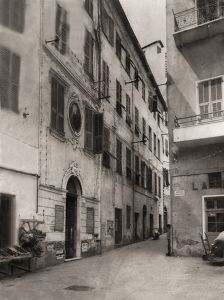
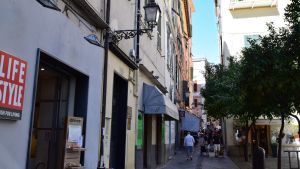 The small church in Piazza Bresca, popularly known as the Church of the Navy, was originally a tavern until the arrival in the district of Pian di Nave of the Fathers of the Mission, members of the homonymous congregation founded in 1625, who, already having an important house in Genoa and wishing to open other houses in Liguria, had applied to the Genoese Senate in the early eighteenth century to open their own annexe in Sanremo. This request, also supported by the population of Sanremo, was based, among other things, on the bequest made in Genoa on 16 November 1708 by the notary Gio Stefano Steneri, with whom the Reverend Orazio Pianavia had donated some goods and capital, estimated at 607,000 lire, so that a Missionary Fathers' headquarters could be established in our city, However, they met the firm opposition of the Matuzian municipal authorities, which, under probable pressure from the other religious orders present in Sanremo, blocked the initiative, since they did not consider the assets made available by the Pianavia bequest sufficient to guarantee the maintenance of the new congregation.
The small church in Piazza Bresca, popularly known as the Church of the Navy, was originally a tavern until the arrival in the district of Pian di Nave of the Fathers of the Mission, members of the homonymous congregation founded in 1625, who, already having an important house in Genoa and wishing to open other houses in Liguria, had applied to the Genoese Senate in the early eighteenth century to open their own annexe in Sanremo. This request, also supported by the population of Sanremo, was based, among other things, on the bequest made in Genoa on 16 November 1708 by the notary Gio Stefano Steneri, with whom the Reverend Orazio Pianavia had donated some goods and capital, estimated at 607,000 lire, so that a Missionary Fathers' headquarters could be established in our city, However, they met the firm opposition of the Matuzian municipal authorities, which, under probable pressure from the other religious orders present in Sanremo, blocked the initiative, since they did not consider the assets made available by the Pianavia bequest sufficient to guarantee the maintenance of the new congregation.
On March 22nd 1719 the Bishop of Albenga Fornari ratified the passage of the two legacies in favor of the missionary fathers established respectively on October 22nd 1693 and February 22nd 1704 by the reverends Antonio Ameglio and Giovanni Battista Oreglia, thus allowing the first two fathers of the Mission to settle on September 29th 1719 in Sanremo, where they were temporarily housed before a villa owned by Captain Giuseppe Rambaldi, and later in some rooms located on the first floor of Palazzo Borea.
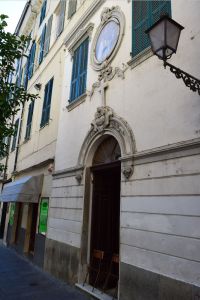
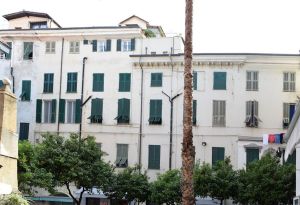 Two years later they finally managed to obtain a small vegetable garden in the port area near the sea, given to them by the Jesuits, while some fathers began to celebrate liturgical services in the small oratory of Pian di Nave, which would later become the Church of the Navy, consisting of a small and low rectangular room with vaulted roofs and inserted in the building that housed the convent of the Missionary Fathers, characterized instead by a regular composition of the facade and an elegant and decent atrium staircase.
Two years later they finally managed to obtain a small vegetable garden in the port area near the sea, given to them by the Jesuits, while some fathers began to celebrate liturgical services in the small oratory of Pian di Nave, which would later become the Church of the Navy, consisting of a small and low rectangular room with vaulted roofs and inserted in the building that housed the convent of the Missionary Fathers, characterized instead by a regular composition of the facade and an elegant and decent atrium staircase.
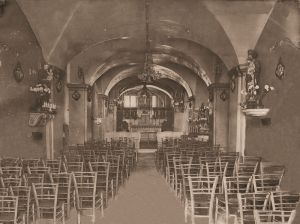 After the subsequent transfer of the missionary friars to another location, the small church of the Navy, as had already happened to the nearby and much older church dedicated to San Mauro, was practically abandoned becoming one of the many modest oratories scattered in large numbers in the town. When the church of San Mauro was demolished by the Genoese in 1755 because it effectively prevented the position of the cannons of the new fortress of Santa Tecla, the church of the Missionaries remained closed and without officiating for almost a century and a half. In memory of the first religious who took care of its spiritual administration, there is still today a marble plaque placed on a doorway, located not far from the entrance of the church, which bears the phrase: «Domus Congregationis Missionis».
After the subsequent transfer of the missionary friars to another location, the small church of the Navy, as had already happened to the nearby and much older church dedicated to San Mauro, was practically abandoned becoming one of the many modest oratories scattered in large numbers in the town. When the church of San Mauro was demolished by the Genoese in 1755 because it effectively prevented the position of the cannons of the new fortress of Santa Tecla, the church of the Missionaries remained closed and without officiating for almost a century and a half. In memory of the first religious who took care of its spiritual administration, there is still today a marble plaque placed on a doorway, located not far from the entrance of the church, which bears the phrase: «Domus Congregationis Missionis».
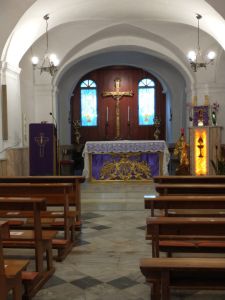 Towards the end of the 19th century the church returned to be officiated regularly on the initiative of the young canon Don Lorenzo Bongiovanni, who took care
Towards the end of the 19th century the church returned to be officiated regularly on the initiative of the young canon Don Lorenzo Bongiovanni, who took care 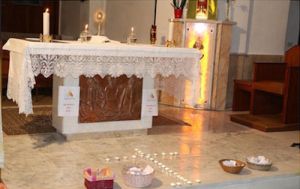 of its careful and meticulous restoration, also having it built as a parish church in 1921 by the bishop of Ventimiglia Daffra, and continuing to reside, where he died in 1929.
of its careful and meticulous restoration, also having it built as a parish church in 1921 by the bishop of Ventimiglia Daffra, and continuing to reside, where he died in 1929.
It is of 1925 an image that shows a Eucharistic Procession at sea due to the initiative of the Canon.
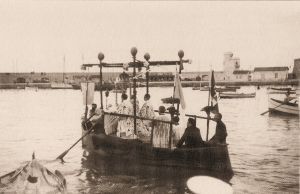
Inside the chapel is preserved among other things a painting depicting St. Vincent de 'Paoli, founder of the Order of the Fathers of the Mission, made by an unknown painter of Western Liguria in the eighteenth century and placed on the left wall of the transept.
Also in the area of Pian di Nave there was in ancient times another small church, dedicated to St. Anthony, which was erected, with the adjoining convent, by the Antoniani friars, and in which the notary Antonio Fabiani founded a chaplaincy on May 17, 1457 provided that the Antoniani fathers did not disturb the chaplain of the related altar, dedicated to St. Antonino.
(sources: text by A.Gandolfo; archive images and Web)




